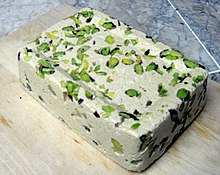
Back حلاوة (طعام) Arabic حلاوة طحينيه ARZ Halva Azerbaijani حالوا AZB Chalva BAT-SMG Халва Byelorussian Халва BE-X-OLD Халва Bulgarian হালুয়া Bengali/Bangla Halva BS
 | |
| Type | Confectionery, dessert |
|---|---|
| Place of origin | Persia |
| Region or state | Middle East, South Asia, Central Asia, Balkans, South Caucasus, North Africa, Horn of Africa |
| Serving temperature | Cold |
Halva (also halvah, halwa, halua,[1] and other spellings; Persian: حلوا) is a type of confectionery originating from Persia (now Iran) and widely spread throughout the Middle East and South Asia. The name is used for a broad variety of recipes, generally a thick paste made from flour, butter, liquid oil, saffron, rosewater, milk, turmeric powder, and sweetened with sugar.[2][3][4][5]
- ^ Clark, Melissa (March 24, 2004). "For Halvah, Use 1/2 Cup Nostalgia". The New York Times. Retrieved November 15, 2020.
- ^ Davidson, Alan (1999). The Oxford Companion to Food. Oxford: Oxford University press. p. 378. ISBN 0-19-211579-0.
- ^ Sharar, Abdul Halim (1994). Lucknow: the last phase of an oriental culture. Oxford University Press. p. 165. ISBN 9780195633757.
- ^ Hosking, R. (2010). Food and Language: Proceedings of the Oxford Symposium on Food and Cooking 2009. Proceedings of the Oxford Symposium on Food and Cookery Series. Prospect Books. p. 202. ISBN 978-1-903018-79-8. Retrieved April 11, 2022.
- ^ Szokovski, Miriam. "How to Make Halva at Home".
© MMXXIII Rich X Search. We shall prevail. All rights reserved. Rich X Search